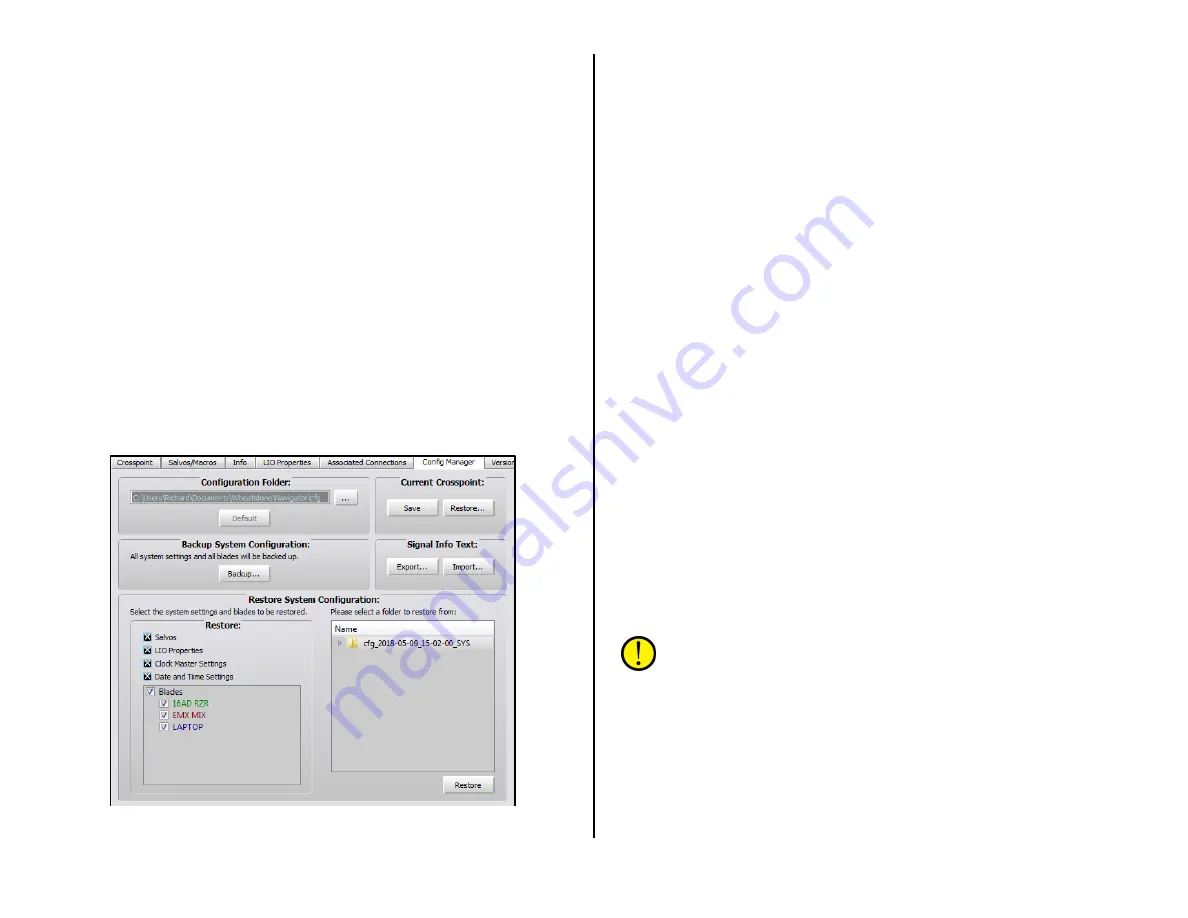
36
Multiple Associated Connections can be assigned to occur with a single
trigger connection. Once all of the Associated Connections are assigned,
clicking the all-important Apply button tells the Blade with the Triggered
Destination to monitor the system waiting for the triggered connection to
occur. When it’s made (in the example PHONE 1 is taken on channel 12)
all of the Associated Connections assigned to that triggered connection are
connected.
Additional details on setting up and using Associated Connections can be
found on page 43.
Config Manager Tab
This tab (Figure 3-22) is used to backup or restore parts of or the entire
system’s configuration. It’s important to periodically save a system backup
(especially after you finish completely setting up a system) so that all of
your system settings are saved so they can be restored if a system device
fails or some other issue occurs.
The Current Crosspoint: section of the tab also allows you to save all
of the current Crosspoint connections to a file which can later be recalled
to restore those crosspoint settings. Clicking Save saves the current
crosspoint connections to a file in: Documents > Wheatstone > Navigator
> Connections. Clicking Restore… opens up a dialog box to select between
the saved crosspoint connection files.
Figure 3-22 Config Manager Tab
If you manually rename the crosspoint files (they get named by the
saved date and time) by an activity or daypart, one can use the Restore
function as an alternative to using a salvo, but with one very important
caveat: using Restore Crosspoint will overwrite locked signals (including
ones locked because the signal is currently on-air) if the crosspoint source
is different than what’s currently connected, whereas a salvo will not
change sources on locked destinations (like on-air channels).
The Configuration Folder: section sets the folder path for saving
configuration files. The default is: Documents > Wheatstone > Navigator >
cfg. Clicking the … button opens up a save dialog box where the path can
be changed. Clicking the Default button restores the save folder to the
default path.
The Backup System Configuration: section allows all system settings
to be backed up by clicking Backup…. A pop-up warning box appears
listing the filename, which includes the date and time. Clicking Yes saves a
separate Blade Config file for each blade within a main folder. The saved
configuration folder is then listed in the Restore System Configuration:
section of the tab. Each of the folders can be expanded to view the saved
file names.
The Restore System Configuration: section is used to restore a saved
configuration. The check boxes, in the Restore: section, allow you to
select which system devices and settings will be restored when the Restore
button is clicked. Click on the name of a saved configuration folder and
then click Restore to restore the configuration settings held in that saved
configuration folder. Once the settings are restored, any Blade that was
restored must be rebooted to use the restored settings.
Version Manager Tab
This tab (Figure 3-23 on page 37) is used to update the Blade (PR&E Mix
Engine, Razor, and M4IP-USB) operating system code. The code is
typically included as part of the PR&E Navigator app, so if the app is
updated there may be also be a new version of operating system code as
well.
Note: Updating the operating system code requires that your copy
of Navigator be licensed. Contact Wheatstone/PR&E support to
obtain a license.
Even though PCs with the WNIP driver installed are identified as Blades,
they are not updated using this process so they are listed in the Blades
not available for an update: section of the tab. This section lists the PC
driver software version so you can identify if you’re running the latest
driver release.
In the Blades available for update: section, checkmark which Blades
to update. Blades can be updated one at a time or all at once. Click Select
All to checkmark all Blades. Click Clear All to uncheck all Blades.
Summary of Contents for EMX
Page 4: ...4 ...






























